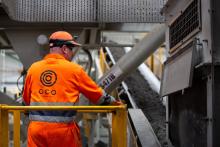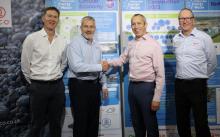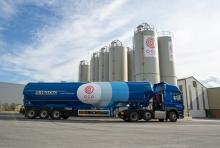The move has also created seven new jobs at the Knowsthorpe Gate facility at Cross Green.
Adding the third production line means the facility can now treat up to 90,000 tonnes of thermal residues every year, producing around 225,000 tonnes of carbon negative aggregate, called Manufactured LimeStone (M-LS), O.C.O’s managing director, Steve Greig, said: “We’re thrilled to have successfully commissioned our third aggregate production line at our Leeds operation.
“This is an important milestone in expanding our capacity and underlines our commitment to both the region and the wider UK economy. It is about creating new jobs and using our innovative technology to accelerate the use of more sustainable building materials in the future.”
M-LS is increasingly sought after by block manufacturers and others in the building sector who see its green credentials as a step forward toward cutting carbon within the construction sector.
Air Pollution Control residues (APCr) are already arriving at the site from the new Hooton Bio Power EfW facility at Ellesmere Port in Cheshire. O.C.O has recently signed deals with Covanta Europe to take some 30,000 tonnes of Air Pollution Control residues (APCr) from two new Energy Recovery Facilities (ERFs) being built in Leicestershire and Cheshire. Further residues will come from Indaver’s operation in Aberdeen.
Greig added: “These new contracts underline O.C.O’s position as a leading recycler of thermal residues in the UK and the only business actively investing and substantially growing its capacity in this sector.”
As part of the project, O.C.O obtained a variation to the site’s Environmental Permit from the Environment Agency (EA), authorising the storage of larger volumes of materials, as well as the additional processing capacity.
The facility remains fully compliant with the EA regulated ‘best available techniques’ for waste processing, with many state-of-the-art components and process philosophies adopted to ensure the safe handling of the residues.
The six-month build programme for the new facility saw O.C.O partner with Yorkshire-based Don Valley Engineering (DVE), which has also now won the contract to develop O.C.O’s new production facility at Wretham in Norfolk. This is expected to be operational by late 2023.
Dan Hobson, sales manager at DVE, said: “Securing the contract for the Leeds expansion was an excellent opportunity for Don Valley Engineering and the increased design resources required allowed for the expansion of our team through the appointment of some high calibre engineers, strengthening our capabilities for the future.
“We are further delighted to have been selected as the supplier of choice for the process modules at the Wretham plant. O.C.O. has been a supportive and progressive company to work with on the Leeds Project, providing the opportunity to develop our working relationship. DVE feels privileged to work in an industry with such positive environmental benefits.”
In addition to the Leeds operation, O.C.O also has facilities in Avonmouth and Suffolk and is now ranked within the top 10 companies in the world for permanent carbon capture in a commercialised process.
Overall, in the 12-month period to the end of September 2021, the company manufactured over 350,000 tonnes of M-LS – enough to build 19,000 houses. This meant diverting more than 143,000 tonnes of thermal residue waste from landfill and the capture of nearly 13,000 tonnes of CO2.









